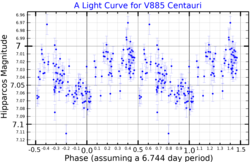Astronomy:HD 101584
 HD 101584 seen by ALMA. The blue component moves towards the observer and the red component moves away from the observer. The green component has the same speed as the binary system, seen as a green point source in the middle. Credit: ALMA (ESO/NAOJ/NRAO), Olofsson et al. Acknowledgement: Robert Cumming | |
| Observation data Equinox J2000.0]] (ICRS) | |
|---|---|
| Constellation | Centaurus |
| Right ascension | 11h 40m 58.80515s[1] |
| Declination | −55° 34′ 25.8147″[1] |
| Apparent magnitude (V) | 7.01 |
| Characteristics | |
| Spectral type | A6Ia[2] |
| Astrometry | |
| Proper motion (μ) | RA: −7.935[1] mas/yr Dec.: −0.243[1] mas/yr |
| Parallax (π) | 0.5452 ± 0.0199[1] mas |
| Distance | 6,000 ± 200 ly (1,830 ± 70 pc) |
| Details | |
| supergiant | |
| Mass | 0.5 - 1[3] M☉ |
| Radius | 18.6[3] R☉ |
| Luminosity | 1,600 L☉ (@1kpc) (400 - 5,000)[3] L☉ |
| Temperature | 8,500[4] K |
| companion | |
| Mass | 0.27 - 0.41[3] M☉ |
| Other designations | |
| Database references | |
| SIMBAD | data |
HD 101584 is a suspected post-common envelope binary about 1,800 to 5,900 light-years distant in the constellation of Centaurus.[3][5] The system is bright at optical wavelengths with an apparent visual magnitude of about 7. The primary is either a post-AGB star, but more likely a post-RGB star. The secondary is a red dwarf or possibly a low-luminosity white dwarf, which orbits the primary every 150-200 days. The system is surrounded by a slowly rotating circumbinary disk, probably with a face-on orientation towards the solar system and a size of about 150 astronomical units.[3]
Variability
HD 101584 has been given the variable star designation V885 Centauri. The International Variable Star Index states that the star varies between visual magnitude 6.90 and 7.02, over a period of 87.9 days.[7] However Koen and Eyer detected, in the star's Hipparcos data, an oscillation of the star's brightness with a period of 6.744 days and an amplitude of only 0.02 magnitudes.[8]
Nebula

The Hubble Space Telescope image shows a diffuse circumstellar environment with a circular ring around HD 101584. ALMA mapped the nebula around HD 101584 and was able to map the region close to the central binary. The nebula consists of a central compact source, an equatorial density enhancement (disk), a high-velocity bipolar outflow and an hourglass structure surrounding the outflow. The outflow reaches a maximum velocity of about 150 km/s and is inclined to the line of sight by 10+10
−5°. There is evidence for a second bipolar outflow with a different orientation from the major outflow.[3] The inner disk, heated to 1540 K, currently has been sublimated by the increasing luminosity of the star.[9]
Evolution
The companion of this system was captured a few hundred years ago, for example when the red giant reached its critical size. It spiralled towards the red giant but stopped before it merged with the core of the primary. During this stage the outer layers of the red giant were ejected. During the common envelope phase the red giant phase of the primary was terminated and the core was revealed.[3] Later, the bipolar jets formed and met the ejected material, forming the hourglass-shaped structure.[5] Ejected material shows prominent spectral features of magnesium,[10] while outer ejected structures contain methanol and formaldehyde.[11]
References
- ↑ Jump up to: 1.0 1.1 1.2 1.3 1.4 Vallenari, A. et al. (2022). "Gaia Data Release 3. Summary of the content and survey properties". Astronomy & Astrophysics. doi:10.1051/0004-6361/202243940 Gaia DR3 record for this source at VizieR.
- ↑ Sivarani, T.; Parthasarathy, M.; García-Lario, P.; Manchado, A.; Pottasch, S. R. (June 1999). "Spectroscopy of the post-AGB star HD 101584 (IRAS 11385-5517)" (in en). Astronomy and Astrophysics Supplement Series 137 (3): 505–519. doi:10.1051/aas:1999259. ISSN 0365-0138. Bibcode: 1999A&AS..137..505S.
- ↑ Jump up to: 3.0 3.1 3.2 3.3 3.4 3.5 3.6 3.7 Olofsson, H.; Khouri, T.; Maercker, M.; Bergman, P.; Doan, L.; Tafoya, D.; Vlemmings, W. H. T.; Humphreys, E. M. L. et al. (March 2019). "HD 101584: circumstellar characteristics and evolutionary status" (in en). Astronomy & Astrophysics 623: A153. doi:10.1051/0004-6361/201834897. ISSN 0004-6361. Bibcode: 2019A&A...623A.153O.
- ↑ Olofsson, H.; Black, J. H.; Khouri, T.; Vlemmings, W. H. T.; Humphreys, E. M. L.; Lindqvist, M.; Maercker, M.; Nyman, L. et al. (2021). "Heavy-element Rydberg transition line emission from the post-giant-evolution star HD 101584". Astronomy and Astrophysics 651: A35. doi:10.1051/0004-6361/202140537. Bibcode: 2021A&A...651A..35O.
- ↑ Jump up to: 5.0 5.1 "ALMA catches beautiful outcome of stellar fight". https://www.almaobservatory.org/en/audiences/alma-catches-beautiful-outcome-of-stellar-fight/.
- ↑ "/ftp/cats/more/HIP/cdroms/cats". Strasbourg astronomical Data Center. https://cdsarc.cds.unistra.fr/viz-bin/ftp-index?/ftp/cats/more/HIP/cdroms/cats.
- ↑ "V0885 Cen". AAVSO. https://www.aavso.org/vsx/index.php?view=detail.top&oid=8182.
- ↑ Koen, Chris; Eyer, Laurent (March 2002). "New periodic variables from the Hipparcos epoch photometry". Monthly Notices of the Royal Astronomical Society 331 (1): 45–59. doi:10.1046/j.1365-8711.2002.05150.x. Bibcode: 2002MNRAS.331...45K.
- ↑ Kluska, J.; Olofsson, H.; Van Winckel, H.; Khouri, T.; Wittkowski, M.; De Wit, W. J.; Humphreys, E. M. L.; Lindqvist, M. et al. (2020), "VLTI/PIONIER reveals the close environment of the evolved system HD 101584", Astronomy & Astrophysics 642: A152, doi:10.1051/0004-6361/202037946, Bibcode: 2020A&A...642A.152K
- ↑ Heavy-element Rydberg transition line emission from the post-giant-evolution star HD 101584
- ↑ Basalgète, R.; Dupuy, R.; Féraud, G.; Romanzin, C.; Philippe, L.; Michaut, X.; Michoud, J.; Amiaud, L. et al. (2021), "Complex organic molecules in protoplanetary disks: X-ray photodesorption from methanol-containing ices", Astronomy & Astrophysics 647: A35, doi:10.1051/0004-6361/202039676
 |


